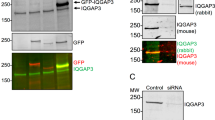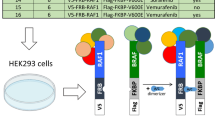Abstract
The RAS GTPase directs cell proliferation and survival by selectively relaying signals amid a dynamic network of regulatory enzymes and protein interactions. Oncogenic mutation of RAS alters cell growth by deleteriously controlling output to RAS-binding effectors. Mechanisms underlying multieffector interactions for both wild-type and oncogenic RAS are poorly understood owing to challenges in quantifying outputs to multiple pathways in parallel. Using highly selective NMR probes for wild-type and oncogenic (G12V) RAS, we develop a systematic approach that quantitatively measures RAS output in composite mixtures of GEF, GAP and effector RAS-binding domains (RBDs). We derive effector signaling hierarchies and establish how oscillating concentrations generate effector 'switching'. The G12V mutation highly perturbs this system, specifically altering interactions with RAL GTPase-specific GEFs and RAF kinases. We further reveal that RAS–RBD complexes show extensive feedback to full-length regulatory proteins. Our approach quantifies output from signaling hubs, here providing an integrated view of the RAS network.
This is a preview of subscription content, access via your institution
Access options
Subscribe to this journal
Receive 12 print issues and online access
$259.00 per year
only $21.58 per issue
Buy this article
- Purchase on Springer Link
- Instant access to full article PDF
Prices may be subject to local taxes which are calculated during checkout






Similar content being viewed by others
References
Vetter, I.R. & Wittinghofer, A. The guanine nucleotide-binding switch in three dimensions. Science 294, 1299–1304 (2001).
Rodriguez-Viciana, P., Sabatier, C. & McCormick, F. Signaling specificity by Ras family GTPases is determined by the full spectrum of effectors they regulate. Mol. Cell. Biol. 24, 4943–4954 (2004).
Rudolph, M.G. et al. Thermodynamics of Ras/effector and Cdc42/effector interactions probed by isothermal titration calorimetry. J. Biol. Chem. 276, 23914–23921 (2001).
Wohlgemuth, S. et al. Recognizing and defining true Ras binding domains I: biochemical analysis. J. Mol. Biol. 348, 741–758 (2005).
Kiel, C., Foglierini, M., Kuemmerer, N., Beltrao, P. & Serrano, L. A genome-wide Ras-effector interaction network. J. Mol. Biol. 370, 1020–1032 (2007).
Scheffzek, K. et al. The Ras–RasGAP complex: structural basis for GTPase activation and its loss in oncogenic Ras mutants. Science 277, 333–338 (1997).
Margarit, S.M. et al. Structural evidence for feedback activation by Ras. GTP of the Ras-specific nucleotide exchange factor SOS. Cell 112, 685–695 (2003).
Gureasko, J. et al. Role of the histone domain in the autoinhibition and activation of the Ras activator Son of Sevenless. Proc. Natl. Acad. Sci. USA 107, 3430–3435 (2010).
Nassar, N. et al. The 2.2 Å crystal structure of the Ras-binding domain of the serine/threonine kinase c-Raf1 in complex with Rap1A and a GTP analogue. Nature 375, 554–560 (1995).
Huang, L., Hofer, F., Martin, G.S. & Kim, S.H. Structural basis for the interaction of Ras with RalGDS. Nat. Struct. Biol. 5, 422–426 (1998).
Pacold, M.E. et al. Crystal structure and functional analysis of Ras binding to its effector phosphoinositide 3-kinase γ. Cell 103, 931–943 (2000).
Kiel, C., Serrano, L. & Herrmann, C. A detailed thermodynamic analysis of ras/effector complex interfaces. J. Mol. Biol. 340, 1039–1058 (2004).
Hamad, N.M. et al. Distinct requirements for Ras oncogenesis in human versus mouse cells. Genes Dev. 16, 2045–2057 (2002).
Karnoub, A.E. & Weinberg, R.A. Ras oncogenes: split personalities. Nat. Rev. Mol. Cell Biol. 9, 517–531 (2008).
Zand, T.P., Reiner, D.J. & Der, C.J. Ras effector switching promotes divergent cell fates in C. elegans vulval patterning. Dev. Cell 20, 84–96 (2011).
Yeh, J.J. & Der, C.J. Targeting signal transduction in pancreatic cancer treatment. Expert Opin. Ther. Targets 11, 673–694 (2007).
Scheffler, J.E. et al. Characterization of a 78-residue fragment of c-Raf-1 that comprises a minimal binding domain for the interaction with Ras-GTP. J. Biol. Chem. 269, 22340–22346 (1994).
Warne, P.H., Viciana, P.R. & Downward, J. Direct interaction of Ras and the amino-terminal region of Raf-1 in vitro. Nature 364, 352–355 (1993).
Zhang, X.F. et al. Normal and oncogenic p21ras proteins bind to the amino-terminal regulatory domain of c-Raf-1. Nature 364, 308–313 (1993).
Smith, M.J., Neel, B.G. & Ikura, M. NMR-based functional profiling of RASopathies and oncogenic RAS mutations. Proc. Natl. Acad. Sci. USA 110, 4574–4579 (2013).
Geyer, M. et al. Conformational transitions in p21ras and in its complexes with the effector protein Raf-RBD and the GTPase activating protein GAP. Biochemistry 35, 10308–10320 (1996).
Spoerner, M., Herrmann, C., Vetter, I.R., Kalbitzer, H.R. & Wittinghofer, A. Dynamic properties of the Ras switch I region and its importance for binding to effectors. Proc. Natl. Acad. Sci. USA 98, 4944–4949 (2001).
Spoerner, M., Wittinghofer, A. & Kalbitzer, H.R. Perturbation of the conformational equilibria in Ras by selective mutations as studied by 31P NMR spectroscopy. FEBS Lett. 578, 305–310 (2004).
González-García, A. et al. RalGDS is required for tumor formation in a model of skin carcinogenesis. Cancer Cell 7, 219–226 (2005).
Mishra, P.J. et al. Dissection of RAS downstream pathways in melanomagenesis: a role for Ral in transformation. Oncogene 29, 2449–2456 (2010).
Vigil, D. et al. Aberrant overexpression of the Rgl2 Ral small GTPase-specific guanine nucleotide exchange factor promotes pancreatic cancer growth through Ral-dependent and Ral-independent mechanisms. J. Biol. Chem. 285, 34729–34740 (2010).
Bauer, B. et al. Effector recognition by the small GTP-binding proteins Ras and Ral. J. Biol. Chem. 274, 17763–17770 (1999).
Sydor, J.R., Engelhard, M., Wittinghofer, A., Goody, R.S. & Herrmann, C. Transient kinetic studies on the interaction of Ras and the Ras-binding domain of c-Raf-1 reveal rapid equilibration of the complex. Biochemistry 37, 14292–14299 (1998).
Linnemann, T., Kiel, C., Herter, P. & Herrmann, C. The activation of RalGDS can be achieved independently of its Ras binding domain. Implications of an activation mechanism in Ras effector specificity and signal distribution. J. Biol. Chem. 277, 7831–7837 (2002).
Herrmann, C. Ras-effector interactions: after one decade. Curr. Opin. Struct. Biol. 13, 122–129 (2003).
Gideon, P. et al. Mutational and kinetic analyses of the GTPase-activating protein (GAP)-p21 interaction: the C-terminal domain of GAP is not sufficient for full activity. Mol. Cell. Biol. 12, 2050–2056 (1992).
Eccleston, J.F., Moore, K.J., Morgan, L., Skinner, R.H. & Lowe, P.N. Kinetics of interaction between normal and proline 12 Ras and the GTPase-activating proteins, p120-GAP and neurofibromin. The significance of the intrinsic GTPase rate in determining the transforming ability of ras. J. Biol. Chem. 268, 27012–27019 (1993).
Weber, C.K. et al. Mitogenic signaling of Ras is regulated by differential interaction with Raf isozymes. Oncogene 19, 169–176 (2000).
Gureasko, J. et al. Membrane-dependent signal integration by the Ras activator Son of sevenless. Nat. Struct. Mol. Biol. 15, 452–461 (2008).
Sondermann, H. et al. Structural analysis of autoinhibition in the Ras activator Son of sevenless. Cell 119, 393–405 (2004).
Takashima, A. & Faller, D.V. Targeting the RAS oncogene. Expert Opin. Ther. Targets 17, 507–531 (2013).
Hofmann, I. et al. K-RAS mutant pancreatic tumors show higher sensitivity to MEK than to PI3K inhibition in vivo. PLoS ONE 7, e44146 (2012).
Roberts, P.J. et al. Combined PI3K/mTOR and MEK inhibition provides broad antitumor activity in faithful murine cancer models. Clin. Cancer Res. 18, 5290–5303 (2012).
Kiel, C., Selzer, T., Shaul, Y., Schreiber, G. & Herrmann, C. Electrostatically optimized Ras-binding Ral guanine dissociation stimulator mutants increase the rate of association by stabilizing the encounter complex. Proc. Natl. Acad. Sci. USA 101, 9223–9228 (2004).
Ader, C., Spoerner, M., Kalbitzer, H.R. & Brunner, E. Solid-state 31P NMR spectroscopy of precipitated guanine nucleotide-binding protein Ras in complexes with its effector molecules Raf kinase and RalGDS. J. Phys. Chem. B 111, 2752–2757 (2007).
Spoerner, M. et al. Conformational states of human rat sarcoma (Ras) protein complexed with its natural ligand GTP and their role for effector interaction and GTP hydrolysis. J. Biol. Chem. 285, 39768–39778 (2010).
Jura, N., Scotto-Lavino, E., Sobczyk, A. & Bar-Sagi, D. Differential modification of Ras proteins by ubiquitination. Mol. Cell 21, 679–687 (2006).
Harding, A., Tian, T., Westbury, E., Frische, E. & Hancock, J.F. Subcellular localization determines MAP kinase signal output. Curr. Biol. 15, 869–873 (2005).
Tian, T. et al. Plasma membrane nanoswitches generate high-fidelity Ras signal transduction. Nat. Cell Biol. 9, 905–914 (2007).
Bivona, T.G. et al. PKC regulates a farnesyl-electrostatic switch on K-Ras that promotes its association with Bcl-XL on mitochondria and induces apoptosis. Mol. Cell 21, 481–493 (2006).
Dougherty, M.K. et al. Regulation of Raf-1 by direct feedback phosphorylation. Mol. Cell 17, 215–224 (2005).
Douville, E. & Downward, J. EGF induced SOS phosphorylation in PC12 cells involves P90 RSK-2. Oncogene 15, 373–383 (1997).
Boykevisch, S. et al. Regulation of ras signaling dynamics by Sos-mediated positive feedback. Curr. Biol. 16, 2173–2179 (2006).
Freedman, T.S. et al. A Ras-induced conformational switch in the Ras activator Son of sevenless. Proc. Natl. Acad. Sci. USA 103, 16692–16697 (2006).
Huang, H. et al. Oncogenic K-Ras requires activation for enhanced activity. Oncogene 10.1038/onc.2012.619 (2013).
Depetris, R.S., Wu, J. & Hubbard, S.R. Structural and functional studies of the Ras-associating and pleckstrin-homology domains of Grb10 and Grb14. Nat. Struct. Mol. Biol. 16, 833–839 (2009).
Boussif, O. et al. A versatile vector for gene and oligonucleotide transfer into cells in culture and in vivo: polyethylenimine. Proc. Natl. Acad. Sci. USA 92, 7297–7301 (1995).
Delaglio, F. et al. NMRPipe: a multidimensional spectral processing system based on UNIX pipes. J. Biomol. NMR 6, 277–293 (1995).
Johnson, B.A. Using NMRView to visualize and analyze the NMR spectra of macromolecules. Methods Mol. Biol. 278, 313–352 (2004).
Acknowledgements
We thank B. Neel, G. Findlay, C. Marshall and M. Mazhab-Jafari for valuable discussion and thoughts on the manuscript. This work was supported by a grant from the Cancer Research Society (to M.I.) and in part by the Canadian Cancer Society (to M.I.) and by the Princess Margaret Hospital Foundation. M.J.S. is the recipient of a Canadian Breast Cancer Foundation Fellowship and an Ontario Cancer Institute Knudson Postdoctoral Fellowship. M.I. holds a Canada Research Chair. The Canada Foundation for Innovation funded the 800- and 600-MHz NMR spectrometers.
Author information
Authors and Affiliations
Contributions
This project was conceived and designed by M.J.S. and M.I. All of the experimental work was performed by M.J.S. The manuscript was prepared by M.J.S. and M.I.
Corresponding author
Ethics declarations
Competing interests
The authors declare no competing financial interests.
Supplementary information
Supplementary Text and Figures
Supplementary Results, Supplementary Figures 1–9 and Supplementary Tables 1–5. (PDF 4381 kb)
Rights and permissions
About this article
Cite this article
Smith, M., Ikura, M. Integrated RAS signaling defined by parallel NMR detection of effectors and regulators. Nat Chem Biol 10, 223–230 (2014). https://doi.org/10.1038/nchembio.1435
Received:
Accepted:
Published:
Issue Date:
DOI: https://doi.org/10.1038/nchembio.1435
This article is cited by
-
The current state of the art and future trends in RAS-targeted cancer therapies
Nature Reviews Clinical Oncology (2022)
-
The origins and genetic interactions of KRAS mutations are allele- and tissue-specific
Nature Communications (2021)
-
NMR in integrated biophysical drug discovery for RAS: past, present, and future
Journal of Biomolecular NMR (2020)
-
Systems NMR: single-sample quantification of RNA, proteins and metabolites for biomolecular network analysis
Nature Methods (2019)
-
Tyrosyl phosphorylation of KRAS stalls GTPase cycle via alteration of switch I and II conformation
Nature Communications (2019)



